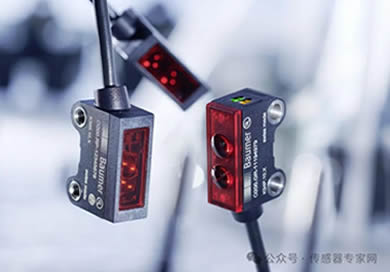1、 Introduction
Optoelectronic sensors, as an indispensable part of modern technology, play an important role in various fields such as industrial automation, robotics, safety systems, and daily life due to their advantages of high precision, fast response, and non-contact detection. From product detection on the production line to environmental perception in smart homes, photoelectric sensors are ubiquitous, greatly promoting technological progress and social development. This article aims to delve into the working principle of photoelectric sensors and provide a detailed introduction to their various classification methods, in order to provide readers with a comprehensive and rigorous scientific knowledge framework.

2、 The working principle of photoelectric sensors
The working principle of photoelectric sensors is based on the photoelectric effect, which means that when light is irradiated onto certain substances, the electrons of the substance absorb the energy of photons, resulting in electrical effects. According to the different mechanisms of photoelectric effect, photoelectric sensors can be divided into three types: external photoelectric effect, internal photoelectric effect, and photovoltaic effect.
1. External photoelectric effect: Under the action of light, electrons can overflow from the surface of an object, such as the working principle of photoelectric devices such as phototubes and photomultiplier tubes.
2. Internal photoelectric effect: Under the action of light, the resistivity of an object changes, such as photoresistors, phototransistors, etc.
3. Photovoltaic effect: Under the action of light, an object generates an electromotive force in a certain direction, such as a photovoltaic cell.
A photoelectric sensor generally consists of three parts: a light source, an optical path, and a photoelectric element. The light source emits a beam of light, which passes through an optical path and illuminates the target object. The photoelectric element receives the reflected or scattered light signal and converts it into an electrical signal. In this process, the performance and structure of optoelectronic components play a decisive role in key indicators such as sensor sensitivity and response time.
3、 Classification of photoelectric sensors
There are many types of photoelectric sensors, which can be classified into multiple types according to different classification standards. Here are some common classification methods:
1. Classification based on working principle
Scattering photoelectric sensor: Utilizing the scattering effect of objects on light, when an object passes through the sensor beam, some of the light is scattered and captured by the sensor, triggering a signal.
Reflective photoelectric sensor: Based on the principle of light reflection, the sensor emits light towards an object. When the light encounters the surface of the object, it is reflected back to the sensor, and the receiver converts the reflected light into an electrical signal.
Infrared photoelectric sensor: Utilizing the penetrability of infrared radiation, it detects small moving or concealed objects and is commonly used in home security systems to detect the presence of human bodies.
Fiber optic sensor: Fully utilizing the transmission characteristics of optical fibers, based on the principles of light interference or scattering, it measures various physical quantities such as pressure, deformation, temperature, humidity, etc. It has the characteristics of wide measurement range, high accuracy, and good stability.
Photodiodes and photomultiplier tube sensors: Based on the principle of photoelectric effect, photodiodes generate current under illumination, and the magnitude of the current is proportional to the intensity of light; Photomultiplier tubes achieve high sensitivity measurement of optical signals through the process of electron multiplication.
2. Classification based on structural form
Slot shaped photoelectric sensor: using a slot shaped structure to block light, the transmitter and receiver are installed face to face on both sides of the slot. When the measured object passes through the slot, the light is blocked, and the photoelectric switch acts and outputs a switch control signal.
Contrastive photoelectric sensor: The transmitter and receiver are located on both sides of the detection path, achieving long-distance detection. When the detection object passes through and blocks the optical path, the receiver operates and outputs a switch control signal.
Reflective plate photoelectric sensor: Integrating the transmitter and receiver into the same device, using a reflective plate for reflection detection. Under normal circumstances, the light emitted by the emitter is reflected back by the reflector and received by the receiver; Once the optical path is blocked by the detected object and the receiver cannot receive light, the photoelectric switch will activate and output a switch control signal.
3. Classification based on application scenarios
Diffuse reflection photoelectric sensor: It integrates a receiver and a transmitter. When an object passes through the optical path and reflects enough light back to the receiver, the photoelectric switch generates a gating signal. Suitable for detecting objects with bright surfaces or extremely high reflectivity.
Mirror reflection type photoelectric sensor: also integrates a receiver and a transmitter, but uses a reflective mirror for reflection detection. When an object blocks the light emitted by the light source emitter and reflects back to the receiver, the photoelectric sensor generates a detection electrical signal.
Safety photoelectric sensors, such as safety reflection photoelectric, safety grating, safety light curtain, etc., are specifically used in the field of safety protection to ensure the safety of personnel and equipment.
Gate controlled photoelectric sensors, such as radar sensors, active sensors, passive sensors, etc., are widely used in scenarios such as automatic doors and elevator light curtains to achieve non-contact object detection and control.
4、 Conclusion
As an important type of sensor, photoelectric sensors play an irreplaceable role in modern technology. Its working principle is based on the photoelectric effect, achieving non-contact object detection and measurement through the conversion of optical signals and electrical signals. According to different classification criteria, photoelectric sensors can be divided into multiple types, each with its unique application scenarios and advantages. With the continuous advancement of technology and changing application demands, photoelectric sensors will play an important role in more fields, promoting technological progress and social development.
Source: Sensor Expert Network



